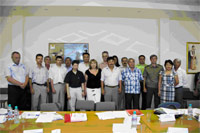Steps to protect globally threatened goose species taken in South-West Russia
 Bonn
Bonn
23rd June - The Interregional Meeting on the Optimization
of the Use of Waterfowl at the Kumo-Manych stopover site
in Kalmykia Republic, Stavropol Krai and Rostov Oblast
took place on 15 of June in Elista, in the south-western
Russian Republic of Kalmykia. Participants included representatives
from the local governments of the three regions mentioned
above, hunters’ organizations, scientists and conservationists
as well as other stakeholders.
The Kumo-Manych Depression is one of the most important
stopover sites for globally threatened waterbirds such
as the Lesser White-fronted Goose (Anser erythropus) and
the Red-breasted Goose (Branta ruficollis). Illegal hunting
is the main threat to these species and hunting pressure
along the Russian flyways and stopover sites is deemed
to be especially high, resulting in a need for vigorous
conservation efforts in these areas.
As a result of the discussions in Elista on the need to
regulate the hunting of waterbirds at Kumo-Manych as an
urgent measure to protect threatened species using the
area during spring and autumn migration, the administration
of Rostov Oblast decided to close spring hunting of waterfowl
for the next five years. Spring hunting within the Kumo-Manych
Depression area in the Republic of Kalmykia has been closed
since 2009 and a further commitment was made at the meeting
not to re-open spring hunting. The meeting also strongly
recommended that the administration of Rostov Oblast increase
the extent of the hunting ban within the buffer zone of
the Biosphere State Reserve “Rostovsky”.
Participants stressed the need for international cooperation
in the monitoring and protection of the Lesser White-fronted
Goose and the Red-breasted Goose. The necessity to apply
for foreign support and funding, especially for the implementation
of urgent measures to regulate hunting, was highlighted.
There was also agreement on the need for better schooling
of hunters and it was decided to organize a series of seminars
for hunters with a focus on the identification of rare
species before the start of the autumn hunting season.
An Interregional Working Group was established to continue
work on these issues. A draft Action Plan for the optimization
of the use of waterfowl at the Kumo-Manych stopover site
will be updated and submitted to the local governments
for adoption.
The meeting was organized as part of the ongoing project “Regulation
of Spring and Autumn Hunting on Waterbirds in the Kumo-Manych
Depression” which is being coordinated by Ms. Sonia
Rozenfeld from the Geese, Swans and Ducks Study Group of
Eastern Europe and North Asia (RGG).
The Norwegian Directorate for Nature Management has provided
the UNEP/AEWA Secretariat with a grant within the framework
of the implementation of the International Single Species
Action Plan for the Lesser White-fronted Goose, which is
in part being used to support the above-mentioned project.
For more information, please contact:
Ms. Nina Mikander,
Coordinator for the Lesser White-fronted Goose
Last updated on 16 June 2014


